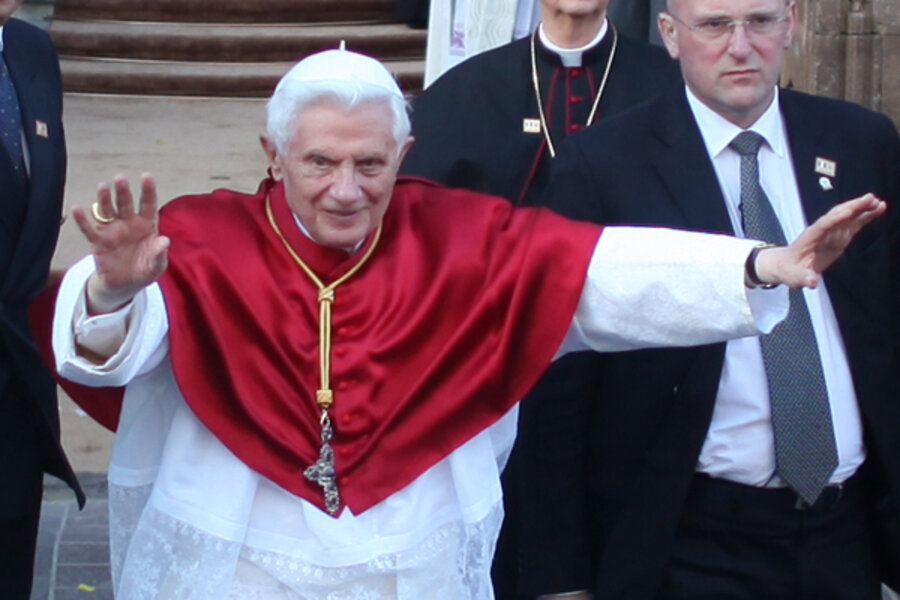Catholicism in a communist land: Pope Benedict XVI travels to Cuba
| Havana, Cuba
Pope Benedict XVI lands in Cuba today, 14 years after the first papal visit to the island. In the years that have passed since Pope John Paul II promised to open the last bastion of communism in the Americas to Catholicism and the world, Cuba has started slowly down a path toward reform.
As the regime gradually warms to religious institutions, Cuban dissidents are hoping this week's papal visit will amplify their voices, long repressed by authorities here. The pope offered them some hope while visiting Mexico last weekend. Yesterday, he entertained several hundred thousand people at an open-air mass in a park outside Silao, Mexico.
"Today it is evident that Marxist ideology in the way it was conceived no longer corresponds to reality," he said, adding that the Catholic Church was ready to help Cuba find new ways of moving forward “without trauma."
It is a long road to democracy and freedom of religion, however. After the 1959 Revolution, the Cuban government expelled priests and nuns, and seized Church property. Believers were banned from the Communist Party, and Cuba became, according to Fidel Castro, an atheist state. But the Catholic Church has proven its ability to push reform in the past. Christmas was once again celebrated as a national holiday just in time for John Paul II's visit in 1998. And the Church has found a more prominent role, led by Cardinal Jaime Ortega, under Raul Castro who has ruled since 2008.
Cuban dissident Oswaldo Payá, sitting in his bare living room in a poor neighborhood of Havana, says he’s grateful for the pope’s pledge to help Cuba move forward.
"We have faith but we know that this change depends on us Cubans," says Mr. Payá, the 2005 nominee for the Nobel Prize and the country's foremost opposition figure. "Our hope for the [pope’s visit] isn't a political change but we want a voice."
The opposition group Las Damas de Blanco, or the Ladies in White, agrees. These women are largely the wives and family members of dissidents arrested in the wake of the Black Spring of 2003, when 75 dissidents, including many journalists, were arrested by Cuban authorities. Every Sunday, the Ladies protest and march through Havana, however last weekend more than 70 were arrested, and released just hours later.
'A message of love'
"The arrival of His Holiness here in Cuba brings a message of love which we the people of Cuba need because we are suffering," says Berta Soler, the leader of the group. She noted many of the Ladies in White were beaten by police during their arrest, yet, they returned to the same church yesterday to continue their weekly ritual of protest. This time, an audience of international press far outnumbered protesters themselves, and though Cuban authorities were present, they did not interfere outside the Santa Rita church on Havana's 5th Avenue, in one of the city's wealthier areas.
"The Cuban people need to have their human rights respected. It's necessary for our freedom,” says Ms. Soler. “But, the pope won't bring freedom,” she says, echoing Payá’s sentiment that Cubans must achieve freedom for themselves.
Inside the church, Father José Pérez Riera was diplomatic in his reaction to what some claim is the hijacking of the Church for political gain. "It's very difficult today for the pope to visit a country without political implications," he says, flanked by posters publicizing Pope Benedict XVI’s visit.
"For the church, [the Ladies in White protest is] neither good or bad; whoever needs the church is welcome," Mr. Riera says, adding that the political action taking place was outside the church's walls.
Payá, the dissident, agrees. "It's not the Church which is stifling our freedom, it's the government," Payá says. He founded the Christian Liberation Movement in 1988, an organization focused on political human rights more so than religion. He said group members have been threatened by authorities recently, told not to come near Papal events.
Many fled religion
The government sees dissidents as a threat to the regime. Through its party newspaper, Granma, the administration has described the country's dissidents as "tiny counter-revolutionary groups ... funded by the Miami anti-Cuba mafia," and the Ladies in White as "mercenaries of the [US] empire."
The pope’s visit to Cuba could be described as a tightrope walk, balancing calls from dissidents and the delicacy demanded by the Cuban state. However, Benedict XVI has his church’s mission and interests to look out for as well. After the revolution largely quashed Catholicism, many believers fled the religion. Other beliefs like Christian Evangelism and the syncretic West African-influenced santería religion were able to fill the void left by the expulsion of the Catholic Church and are now major influences on the religious landscape here.
Weighing meat in a set of old fashioned scales in central Havana, butcher Ismael Camacho points towards a portrait of Fidel Castro on his faded green wall. "This is our pope," he says proudly.






